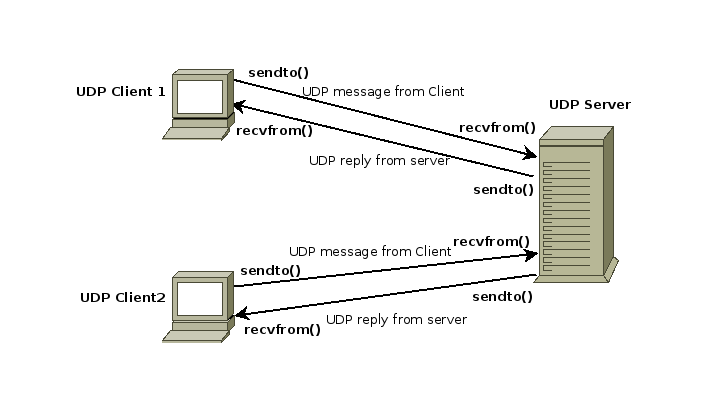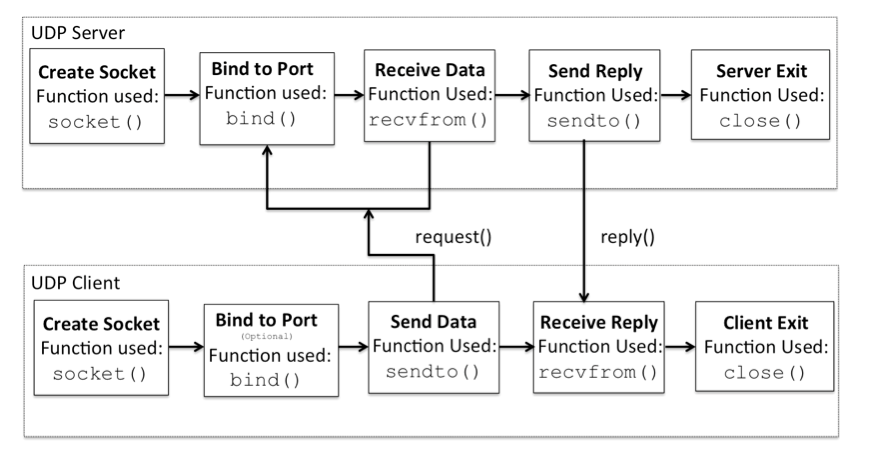UDP Communication
Here’s simple code to post a note by UDP in Python 3:
1 import socket 2 3 UDP_IP = "127.0.0.1" 4 UDP_PORT = 5005 5 MESSAGE = b"Hello, World!" 6 7 print("UDP target IP: %s" % UDP_IP) 8 print("UDP target port: %s" % UDP_PORT) 9 print("message: %s" % MESSAGE) 10 11 sock = socket.socket(socket.AF_INET, # Internet 12 socket.SOCK_DGRAM) # UDP 13 sock.sendto(MESSAGE, (UDP_IP, UDP_PORT))
Receiving
Here’s simple code to receive UDP messages in Python 3:
1 import socket 2 3 UDP_IP = "127.0.0.1" 4 UDP_PORT = 5005 5 6 sock = socket.socket(socket.AF_INET, # Internet 7 socket.SOCK_DGRAM) # UDP 8 sock.bind((UDP_IP, UDP_PORT)) 9 10 while True: 11 data, addr = sock.recvfrom(1024) # buffer size is 1024 bytes 12 print("received message: %s" % data)
Using UDP for e.g. File Transfers
If considering extending this example for e.g. file transfers, keep in mind that UDP is not reliable. So you’ll have to handle packets getting lost and packets arriving out of order. In effect, to get something reliable you’ll need to implement something similar to TCP on top of UDP, and you might want to consider using TCP instead.
That being said, sometimes you need to use UDP, e.g. for UDP hole punching. In that case, consider TFTP for python or UDT for python
Multicasting?
The official example of multicast can be found at /usr/share/doc/python2.3/examples/Demo/sockets/mcast.py (at least on Debian Sarge, after apt-get install python-examples). It worked on my machine, but I have yet to try it running on different machines. — — 200.138.245.121 2006-08-09 03:20:30
I’ve been googling for some time now, and still have yet to find a working example of Python multicast listening.
(The example below has been updated to work — Steven Spencer 2005-04-14 13:19:00)
(I’ve replaced it with one that works. — Asgeir S. Nilsen 2005-05-09 19:25:00)
(I’ve corrected the mreq according to the comment below — Sebastian Setzer 2006-01-25 14:28:00)
(I added an «=» to the «4sl» struct packing. Both the old version and the new version work on my 32-bit machine, but the Python documentation for the struct module suggests that «l» would be 64 bits on an LP64 or LPI64 platform without it, so I thought it would be prudent to add. — Kragen Sitaker 2010-04-28 07:03:00)
1 import socket 2 import struct 3 4 sock = socket.socket(socket.AF_INET, socket.SOCK_DGRAM, socket.IPPROTO_UDP) 5 sock.setsockopt(socket.SOL_SOCKET, socket.SO_REUSEADDR, 1) 6 sock.bind(('', 4242)) 7 # wrong: mreq = struct.pack("sl", socket.inet_aton("224.51.105.104"), socket.INADDR_ANY) 8 mreq = struct.pack("=4sl", socket.inet_aton("224.51.105.104"), socket.INADDR_ANY) 9 10 sock.setsockopt(socket.IPPROTO_IP, socket.IP_ADD_MEMBERSHIP, mreq) 11 12 while True: 13 print(sock.recv(10240))
The mreq packing is based on some code that I found, that does not work. On my computer, at least.
Sending to multicast groups is just fine; Here’s some functional text:
1 import socket 2 3 sock = socket.socket(socket.AF_INET, socket.SOCK_DGRAM, socket.IPPROTO_UDP) 4 sock.setsockopt(socket.IPPROTO_IP, socket.IP_MULTICAST_TTL, 2) 5 sock.sendto(b"robot", ("239.192.0.100", 1000))
(You might want to reconsider the IP_MULTICAST_TTL setting here — the recommended value for local-network multicasts is < 32, whilst a value >32 indicates multicasts which should traverse onto the Internet — Asgeir S. Nilsen)
Note the above example is missing a bind() call. This will work OK if there is a multicast route setup in the IP routing table But without a bind() nor route, the kernel will not determine which network interface to send the data on, and will return an error. There may be other ways for the «socket to network interface» mapping to be defined, but I forget what they are. (Chris David)
The above multicasting examples do not work on my computer, but I was able to fix them using code from http://sourceforge.net/projects/pyzeroconf. Try these examples:
1 # UDP multicast examples, Hugo Vincent, 2005-05-14. 2 import socket 3 4 def send(data, port=50000, addr='239.192.1.100'): 5 """send(data[, port[, addr]]) - multicasts a UDP datagram.""" 6 # Create the socket 7 s = socket.socket(socket.AF_INET, socket.SOCK_DGRAM) 8 # Make the socket multicast-aware, and set TTL. 9 s.setsockopt(socket.IPPROTO_IP, socket.IP_MULTICAST_TTL, 20) # Change TTL (=20) to suit 10 # Send the data 11 s.sendto(data, (addr, port)) 12 13 def recv(port=50000, addr="239.192.1.100", buf_size=1024): 14 """recv([port[, addr[,buf_size]]]) - waits for a datagram and returns the data.""" 15 16 # Create the socket 17 s = socket.socket(socket.AF_INET, socket.SOCK_DGRAM) 18 19 # Set some options to make it multicast-friendly 20 s.setsockopt(socket.SOL_SOCKET, socket.SO_REUSEADDR, 1) 21 try: 22 s.setsockopt(socket.SOL_SOCKET, socket.SO_REUSEPORT, 1) 23 except AttributeError: 24 pass # Some systems don't support SO_REUSEPORT 25 s.setsockopt(socket.SOL_IP, socket.IP_MULTICAST_TTL, 20) 26 s.setsockopt(socket.SOL_IP, socket.IP_MULTICAST_LOOP, 1) 27 28 # Bind to the port 29 s.bind(('', port)) 30 31 # Set some more multicast options 32 intf = socket.gethostbyname(socket.gethostname()) 33 s.setsockopt(socket.SOL_IP, socket.IP_MULTICAST_IF, socket.inet_aton(intf)) 34 s.setsockopt(socket.SOL_IP, socket.IP_ADD_MEMBERSHIP, socket.inet_aton(addr) + socket.inet_aton(intf)) 35 36 # Receive the data, then unregister multicast receive membership, then close the port 37 data, sender_addr = s.recvfrom(buf_size) 38 s.setsockopt(socket.SOL_IP, socket.IP_DROP_MEMBERSHIP, socket.inet_aton(addr) + socket.inet_aton('0.0.0.0')) 39 s.close() 40 return data
- Are you running on Windows 2000/XP (pre-SP2)/Server 2003 with more than one network adapter? If so, the problem is Windows, not Python. The original code works for me on Windows 2000 (1 network adapter), but fails under XP Pro (pre-SP2, 3 adapters though 2 are disabled). Microsoft has a support page on the issue. The problem appears to be in the receiver: with both machines running the receiver, the Win2K machine sees packets sent from both machines, while the receiver on XP sees messages sent from the Win2K machine only. This, despite specifying the local IP address of the appropriate adapter in the second part of the mreq structure in the IP_ADD_MEMBERSHIP call. — VinaySajipHm, that’s interesting. No, I’m not running on Windows; I’m running on FC3. That said, I hadn’t considered the machine as a possible problem. What I’ll do is this: I’ll run this on my home FC3 computer, and on my home Redhat 9 computer, and see if I can get it to work on one of them. — LionKimbro 2005-01-20 02:07:18 The new version still doesn’t work for me. I mean, it does work for local traffic: the host talking with itself. But as soon as I get to another link-local computer, and do the same over again, it doesn’t work. I’ve replaced 127.0.0.1 with the actual IP address of the computer, and I’ve shut down the firewall (service iptables stop). No dice. This is all on my FC3 host, again. — LionKimbro 2005-04-14 17:27:42 When implementing multicast, it’s important to understand the requirements of IGMP, especially when working in a switched network. IGMP describes how routers should exchange membership information, but does not describe how layer 2 switches should handle this. Many switches have a feature called IGMP snooping, where the switch snoops for IGMP traffic, thereby gaining knowledge of which switch ports belong to a multicast group. Cheap switches typically either does not handle this or handles it wrongly. — Asgeir S. Nilsen 2005-05-09 19:39:00 The first version, I tested side-by-side equivalent C code. The C code worked, the Python code did not. Thus, I ruled out special router, switch, hub issues. However, the second version, I just ran the Python code. I did not test vis-a-vis C code. Sol, I will have to try it vis-a-vis C code, again, to be sure. — LionKimbro 2005-05-09 22:56:26
It’s too bad we don’t have anything as simple as this:
1 import UDP 2 3 sock = UDP.MulticastListener("239.192.0.100", 1000) # Listen on port 1000 4 print sock.recv(100)
1 import UDP 2 3 UDP.send("Hello, world!", "239.192.0.100", 1000)
You could do something like this:
1 class McastSocket(socket.socket): 2 def __init__(self, local_port, reuse=False): 3 socket.socket.__init__(self, socket.AF_INET, socket.SOCK_DGRAM, socket.IPPROTO_UDP) 4 if(reuse): 5 self.setsockopt(socket.SOL_SOCKET, socket.SO_REUSEADDR, 1) 6 if hasattr(socket, "SO_REUSEPORT"): 7 self.setsockopt(socket.SOL_SOCKET, socket.SO_REUSEPORT, 1) 8 self.bind(('', local_port)) 9 def mcast_add(self, addr, iface): 10 sock.setsockopt( 11 socket.IPPROTO_IP, 12 socket.IP_ADD_MEMBERSHIP, 13 socket.inet_aton(mcast_addr) + socket.inet_aton(mcast_iface))
Then to listen to multicast events locally:
1 sock = McastSocket(local_port=12345, reuse=1) 2 sock.mcast_add('239.192.9.9', '127.0.0.1')
The perl IO::Socket::Multicast class doesn’t look much different from this.
I was able to get the above example to work fine on a linux platform, with one small change. I had to put a «4sl» in the pack statement for creating mreq. It seems as if when I didn’t have a 4, the pack statement was just using the first octet (somehow dropping the other octets), so I could only create the multi-cast «listener» on a 234.0.0.0 ip. After some debugging, I put the 4 in front of the «s», which forced it to get all 4 octets from the inet_aton, and everything worked fine. Hope this helps.
- For the «s» format character, the count is interpreted as the size of the string, . For packing, the string is truncated or padded with null bytes as appropriate to make it fit.
=UPDATE:= Definitive UDP multicasting example code can be found in PyZeroConf at http://sourceforge.net/projects/pyzeroconf
How can it be definitive, if you have to download a whole project in order to read simply how to do multicasting in Python?
* How to Write New Components for Kamaelia has example code for doing multicast send and receipt at the top.
UdpCommunication (last edited 2020-05-19 21:27:34 by JonathanVirga )
UDP — Client And Server Example Programs In Python
UDP is the abbreviation of User Datagram Protocol. UDP makes use of Internet Protocol of the TCP/IP suit. In communications using UDP, a client program sends a message packet to a destination server wherein the destination server also runs on UDP.
Properties of UDP:
- The UDP does not provide guaranteed delivery of message packets. If for some issue in a network if a packet is lost it could be lost forever.
- Since there is no guarantee of assured delivery of messages, UDP is considered an unreliable protocol.
- The underlying mechanisms that implement UDP involve no connection-based communication. There is no streaming of data between a UDP server or and an UDP Client.
- An UDP client can send «n» number of distinct packets to an UDP server and it could also receive «n» number of distinct packets as replies from the UDP server.
- Since UDP is connectionless protocol the overhead involved in UDP is less compared to a connection based protocol like TCP.
Example: UDP Server using Python
msgFromServer = «Hello UDP Client»
UDPServerSocket = socket.socket(family=socket.AF_INET, type=socket.SOCK_DGRAM)
print(«UDP server up and listening»)
# Listen for incoming datagrams
clientMsg = «Message from Client:<>«.format(message)
clientIP = «Client IP Address:<>«.format(address)
# Sending a reply to client
Output:
UDP server up and listening
Message from Client:b»Hello UDP Server»
Client IP Address:(«127.0.0.1», 51696)
Example: UDP Client using Python
msgFromClient = «Hello UDP Server»
serverAddressPort = («127.0.0.1», 20001)
# Create a UDP socket at client side
UDPClientSocket = socket.socket(family=socket.AF_INET, type=socket.SOCK_DGRAM)
# Send to server using created UDP socket
msg = «Message from Server <>«.format(msgFromServer[0])
Output:
Message from Server b»Hello UDP Client»

